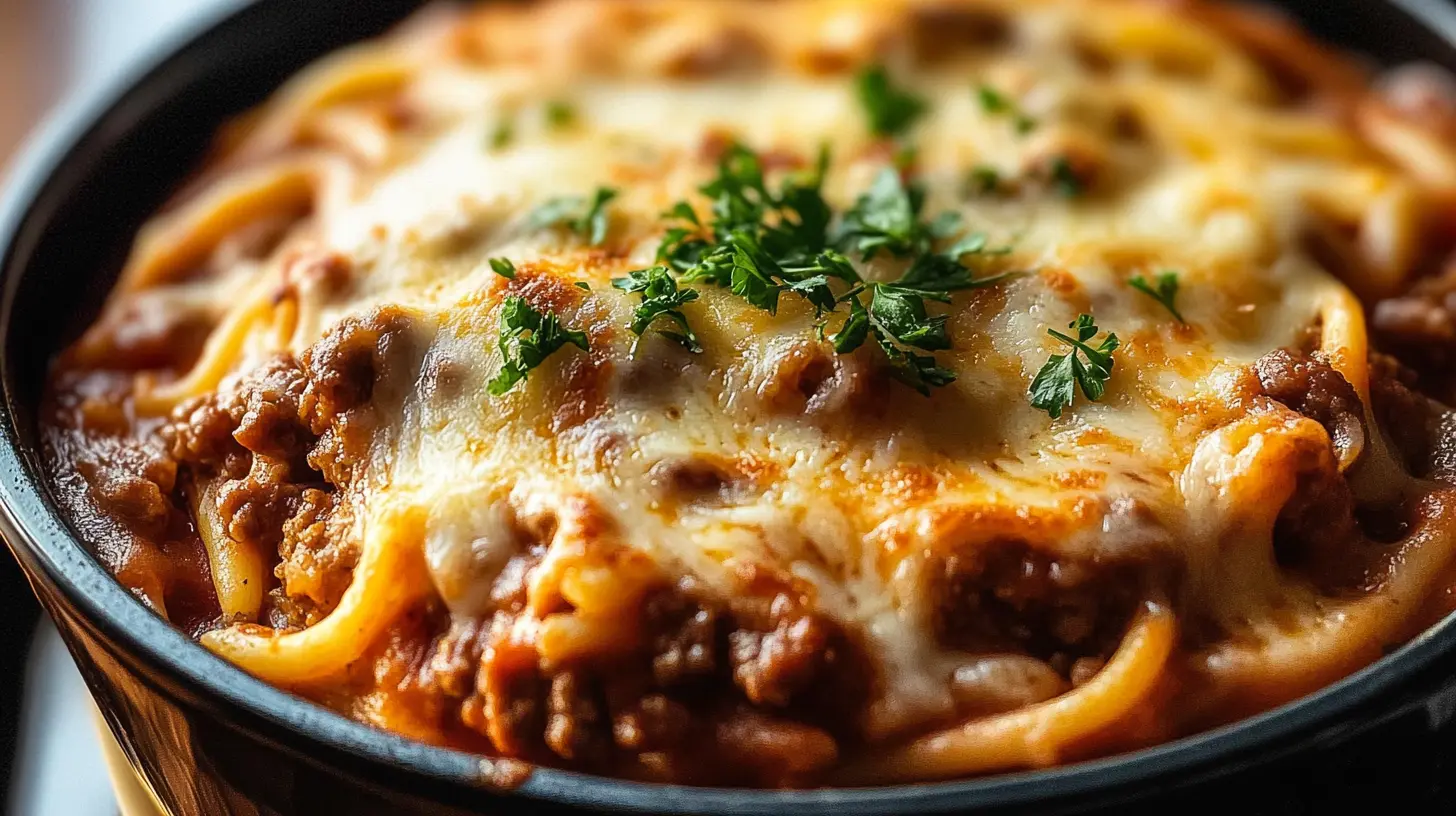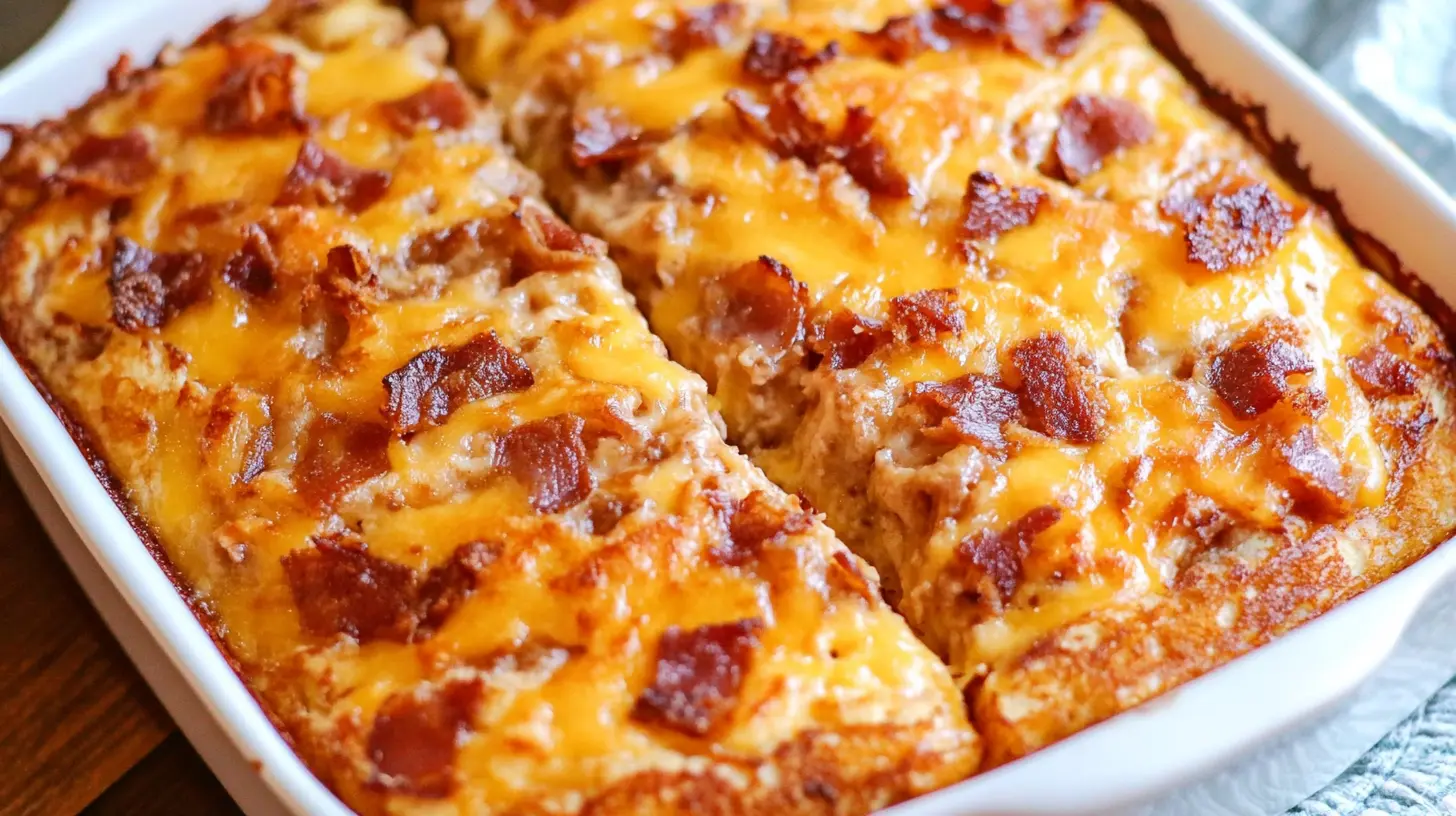Introduction to Lasagna Pasta
Lasagna pasta, a timeless classic, combines layers of pasta sheets, rich meat sauce, creamy béchamel, and a melty cheese topping to create a hearty and satisfying meal. Whether you’re cooking for a family dinner, a gathering with friends, or prepping meals for the week, this lasagna pasta recipe offers both simplicity and versatility. With options to make it gluten-free, vegan, or low-calorie, this dish can easily fit into various dietary needs, making it an ideal choice for home cooks, busy parents, and even diet-conscious individuals. If you’re looking for more comfort food recipes, you might also enjoy our Cheesy Hot Beef Sandwich Recipe, which is another delicious option for a cozy meal.
Benefits and Advantages of Lasagna Pasta
Lasagna pasta is more than just a delicious dish—it also offers numerous benefits that make it a great addition to your recipe collection.
Ease of Preparation
Lasagna pasta may seem like a complex dish, but it’s surprisingly easy to prepare. By following a few straightforward steps, you can create a meal that looks and tastes impressive without much hassle. Moreover, this dish can be made in advance, which makes it perfect for meal prepping or serving at gatherings. You can even freeze portions for a quick and convenient meal later on. If you enjoy dishes that are simple yet satisfying, our Tteokbokki Recipe might also be a hit in your kitchen.
Health Benefits and Versatility
Lasagna pasta is versatile enough to fit various dietary needs. By choosing whole grain or gluten-free pasta sheets, you can boost the nutritional content and cater to gluten-sensitive individuals. In addition, adding a variety of vegetables to the layers can enhance the fiber and nutrient profile, making it a wholesome meal option. For those on a low-carb diet, substituting pasta sheets with zucchini slices offers a delicious alternative.
Crowd-Pleaser and Adaptable for Many Diets
Lasagna is a well-loved dish that appeals to a wide range of palates. Whether you prefer the classic beef lasagna or a vegetarian version loaded with veggies, there’s a lasagna recipe for everyone. It’s also an excellent choice for potlucks and parties, as it’s easy to serve and satisfies both kids and adults alike. If you’re exploring more crowd-pleasing dishes, try our Brown Sugar Cake Recipe for a sweet, decadent finish to your meal.
Ingredients Overview
Essential Ingredients for Lasagna Pasta
To create a delicious lasagna pasta, you will need the following essential ingredients:
- Lasagna Pasta Sheets: You can use regular, whole wheat, or gluten-free pasta sheets depending on your dietary preference.
- Ground Beef or Turkey (1 lb): Offers a rich, meaty flavor. Ground turkey provides a leaner alternative.
- Tomato Sauce (2 cups): Forms the base of the rich meat sauce. You can use store-bought or homemade.
- Onion and Garlic: Adds depth of flavor to the meat sauce.
- Ricotta Cheese (1 cup): Adds creaminess to the layers.
- Mozzarella Cheese (2 cups, shredded): Melts beautifully to create a gooey, cheesy topping.
- Parmesan Cheese (1/2 cup, grated): Adds a nutty, salty flavor.
- Béchamel Sauce (1 cup): A creamy white sauce that adds richness.
- Olive Oil (2 tablespoons): Used for sautéing.
- Italian Seasoning (1 teaspoon): Adds a blend of herbs that enhances the flavor.
Dietary Substitutions to Customize Your Lasagna Pasta
To accommodate different dietary needs, here are some substitutions you can make:
- Vegan: Use a plant-based meat substitute, vegan cheese, and replace béchamel with a cashew cream sauce.
- Gluten-Free: Substitute regular pasta sheets with gluten-free lasagna sheets.
- Low-Calorie: Use zucchini or eggplant slices instead of pasta sheets to reduce calories.
- Dairy-Free: Replace cheese with dairy-free alternatives and use a dairy-free béchamel sauce.
How to Prepare the Perfect Lasagna Pasta: Step-by-Step Guide
First Step: Prepare the Meat Sauce
- Sauté the Vegetables: Heat olive oil in a skillet over medium heat. Add chopped onions and garlic; cook until softened.
- Cook the Meat: Add ground beef or turkey to the skillet. Cook until browned, breaking it up with a spoon.
- Add the Tomato Sauce: Stir in tomato sauce and Italian seasoning. Let it simmer for 15 minutes to develop the flavors.
Second Step: Prepare the Béchamel Sauce
- Melt Butter: In a separate saucepan, melt butter over medium heat.
- Add Flour: Stir in flour and cook for 1-2 minutes.
- Whisk in Milk: Gradually add milk, whisking continuously to prevent lumps. Cook until the sauce thickens, then set aside.
Third Step: Assemble the Lasagna
- Layer the Ingredients: In a baking dish, start with a layer of meat sauce, followed by lasagna sheets, ricotta, béchamel sauce, and shredded mozzarella.
- Repeat: Continue layering until all ingredients are used, finishing with a layer of mozzarella and Parmesan cheese.
Fourth Step: Bake the Lasagna
- Preheat the Oven: Preheat your oven to 375°F (190°C).
- Bake: Cover the lasagna with aluminum foil and bake for 25 minutes. Remove the foil and bake for an additional 20 minutes until the cheese is bubbly and golden.
- Let it Rest: Allow the lasagna to rest for 10 minutes before serving to set.
Mastering Lasagna Pasta: Advanced Tips and Variations
Tips for Perfect Lasagna Pasta
- Use Fresh Ingredients: Fresh vegetables and herbs can enhance the flavor of your lasagna.
- Don’t Overcook the Pasta Sheets: Par-cook the sheets to avoid a mushy texture.
- Let It Rest: Allow the lasagna to rest after baking to prevent it from falling apart when slicing.
Variations to Try
- Vegetable Lasagna: Layer in zucchini, spinach, mushrooms, and bell peppers for a vegetarian version.
- Seafood Lasagna: Replace meat with shrimp, crab, or a white fish, and use a white sauce.
- Mexican Lasagna: Substitute lasagna sheets with tortillas and add Mexican seasonings, black beans, and corn.
How to Store Lasagna Pasta: Best Practices
- Refrigeration: Store leftover lasagna in an airtight container in the refrigerator for up to 3 days.
- Freezing: Freeze portions for up to 2 months. To reheat, thaw in the refrigerator overnight and bake at 350°F (175°C) until heated through.
- Reheating: Reheat in the oven or microwave. If using a microwave, cover with a damp paper towel to retain moisture.
Nutritional Value of Lasagna Pasta
- Calories: Approximately 400-450 per serving, depending on ingredients.
- Fat: 20-25 grams, mostly from cheese and meat.
- Carbohydrates: 30-40 grams, primarily from pasta.
- Protein: 20-25 grams, depending on the meat and cheese used.
- Fiber: 3-5 grams, from vegetables and whole grain pasta (if used).
FAQs: Frequently Asked Questions About Lasagna Pasta
Can You Make Lasagna Ahead of Time?
Yes, you can assemble lasagna a day in advance and refrigerate it. Bake it fresh when you’re ready to serve.
Can You Freeze Lasagna Pasta?
Absolutely! Lasagna freezes well. Make sure it’s properly covered and sealed to prevent freezer burn.
How Do You Keep Lasagna from Getting Watery?
Use less sauce and ensure the pasta sheets are dry before layering. Allowing the lasagna to rest after baking also helps absorb excess moisture.
What kind of pasta is used in lasagna?
Lasagna uses wide, flat pasta sheets known as “lasagna noodles” or “lasagne sheets.” These sheets are designed specifically for layering with sauces, cheeses, and fillings. Made primarily from durum wheat flour and water, some varieties also include eggs. The flat, wide shape allows for even layers and helps hold the rich fillings together during baking.
Is lasagna a noodle or pasta?
Lasagna is a type of pasta. The term “pasta” includes any dough made from wheat flour and water (or eggs) that is shaped into different forms. In the case of lasagna, it refers to both the dish and the pasta sheets used in its preparation. While these sheets are sometimes called noodles in American English, they differ from long, thin noodles like spaghetti.
Why is lasagna a pasta?
We classify lasagna as pasta because it shares the same basic ingredients with other types: flour, water, and sometimes eggs. The main difference is its shape—flat and wide sheets perfect for layering in a baked dish with various fillings. Despite its unique baking process and layered construction, lasagna remains fundamentally a type of pasta due to its ingredients and preparation.
Can I use lasagna sheets as pasta?
Yes, you can use lasagna sheets as pasta in other dishes. For example, cut the sheets into smaller pieces to create different shapes like pappardelle. You can also roll lasagna sheets with fillings to make dishes like cannelloni or cut them into squares for soups. Keep in mind, though, that lasagna sheets are usually thicker than other types of pasta, so cooking times might differ.
What is lasagna made of in Italy?
In Italy, traditional lasagna (or “lasagne” in Italian) consists of layers of pasta sheets, ragù (a meat-based tomato sauce), béchamel sauce (a creamy white sauce), and Parmigiano-Reggiano cheese. In regions like Bologna, the pasta dough often includes spinach, giving the sheets a distinctive green color. Italian lasagna emphasizes quality ingredients and balance between layers, and it varies significantly across different regions. For more on lasagna variations in Italy, check out Italian cuisine on Wikipedia.
What do Italians call lasagna noodles?
Italians refer to the pasta sheets used in lasagna as “lasagne.” The term “lasagne” is plural in Italian and refers to the individual sheets. In contrast, “lasagna” in English often denotes the entire dish. Italians do not typically use the term “noodles” for these sheets; this is more of an American adaptation.
What is the English of lasagna?
In English, “lasagna” describes both the flat pasta sheets used in the dish and the baked casserole made by combining these sheets with meat, cheese, and sauce. This differs slightly from Italian usage, where “lasagna” is singular and “lasagne” is plural.
Is lasagne healthy?
Lasagna can be both healthy and indulgent, depending on its preparation. A traditional lasagna may be high in calories, fat, and carbohydrates because of ingredients like ground meat, béchamel sauce, cheese, and pasta. However, making a healthier version is possible by using lean ground turkey or chicken, low-fat cheeses, whole-grain pasta, and plenty of vegetables. You can also opt for a vegetarian or vegan lasagna to reduce fat and calorie content while increasing fiber and nutrient levels.
Is lasagna basically spaghetti?
No, lasagna and spaghetti are distinct dishes, even though both are made with pasta and often feature similar ingredients like tomato sauce and cheese. Lasagna is a baked dish with layered pasta sheets, while spaghetti consists of long, thin pasta served with sauce on top. The main differences lie in their form and preparation: lasagna is a layered, baked casserole, whereas spaghetti is a simple, boiled pasta dish served with sauce.
What is the difference between lasagna and lasagne?
In Italian, “lasagna” refers to a single sheet of pasta, while “lasagne” is the plural form, indicating multiple sheets. However, in English, “lasagna” often refers to the entire dish, while “lasagne” can sometimes be used to mean the same thing or refer to the sheets of pasta themselves. The difference mainly lies in the linguistic and cultural interpretations.
Which country food is lasagna?
Lasagna originates from Italy, specifically the Emilia-Romagna region. It is a quintessential Italian dish that has become popular worldwide. Different regions in Italy have their own variations of lasagna, but the most well-known version, featuring ragù, béchamel sauce, and Parmigiano-Reggiano cheese, comes from Bologna.
What do real Italians call pasta?
Italians simply refer to pasta as “pasta.” Different shapes and types have specific names, such as spaghetti, penne, fusilli, or lasagne. In Italy, pasta is a fundamental part of the diet and is appreciated for its versatility and ability to carry a wide range of flavors.
Should I cover lasagna with foil?
Yes, cover lasagna with foil during the initial stages of baking. This step prevents the top layer of cheese from browning too quickly and ensures the dish cooks evenly. After about two-thirds of the total cooking time, remove the foil to let the cheese on top turn golden and bubbly. This approach allows the lasagna to cook through properly while achieving a perfectly browned top.
How to soften lasagna noodles without boiling?
To soften lasagna noodles without boiling, soak them in hot water. Place the dry noodles in a large baking dish or tray and pour hot water over them until they are fully submerged. Allow the noodles to soak for about 20-30 minutes, or until they become pliable but not fully cooked. This method softens the noodles without causing them to stick together or become overly soft.
Can you eat undercooked lasagne sheets?
Eating undercooked lasagne sheets is not recommended. Raw or undercooked pasta tends to be tough to chew and hard to digest, and it often has an unpleasant texture and taste. Always make sure lasagna sheets are fully cooked before serving. If using no-boil lasagna sheets, cover them thoroughly with sauce during baking to soften them properly.
Can you eat 10-year-old dried pasta?
Although dried pasta has a long shelf life, eating pasta that is 10 years old isn’t advisable. Over time, dried pasta can lose its flavor, texture, and quality. If the pasta has been stored properly in a cool, dry place and shows no signs of spoilage, such as mold or an off odor, it might still be safe to consume. However, for optimal taste and texture, it’s best to use dried pasta within 1-2 years of purchase.
Conclusion
Lasagna pasta is a versatile, comforting dish that everyone can enjoy. Whether you prefer a traditional meat lasagna or a vegetarian version, this recipe offers flexibility and delicious results. With the tips and variations provided, you can easily customize the dish to suit your dietary needs and preferences. For more comfort food recipes, don’t miss out on our Nestle Chocolate Chip Cookie Recipe to complete your meal with a sweet treat!

Posted by: Hailee | November 7, 2024
I’m passionate about sharing sweet and savory recipes that I’ve meticulously tested and perfected in my own kitchen. Join me on this delicious journey to experience the best of culinary creativity.





1 thought on ““Lasagna Pasta Recipe: A Classic Italian Comfort Food””